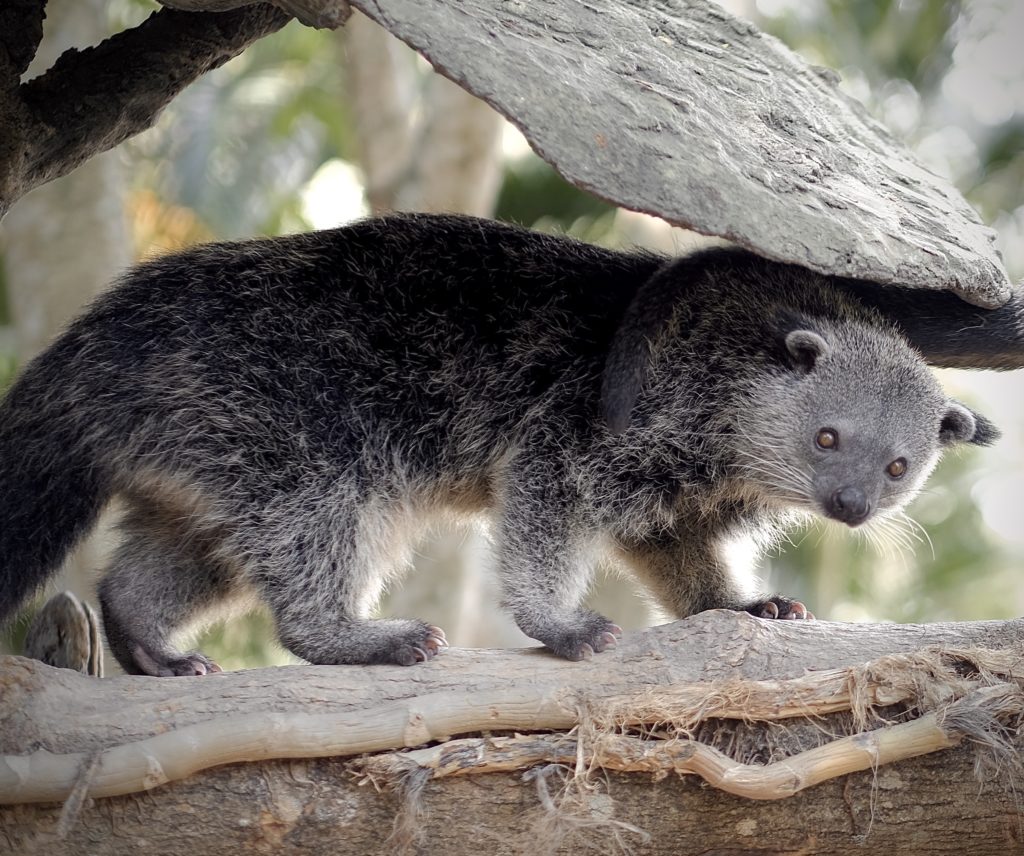Wandering through the tropical rainforests of Southeast Asia, nature explorers may occasionally catch an unusual scent in the air—one that smells strikingly like hot, buttered popcorn.
No, it’s not an open-air cinema deep in the jungle—it’s the unmistakable calling card of a unique creature known as the binturong.
This animal stands out not only because of its appearance—like a mix between a bear and a cat—but also because of the mouthwatering aroma it naturally gives off.
A Glimpse of the Binturong: The Canopy’s Enigmatic Resident
The binturong (Arctictis binturong), often nicknamed the "bearcat," is neither a bear nor a cat. It belongs to the Viverridae family, making it a relative of civets and linsangs. With a large body, shaggy black fur, and long white whiskers, the binturong looks like a character straight out of a jungle fairytale.
Its body can reach up to 90 cm (about 3 feet) in length—excluding its prehensile tail, which is nearly as long as its body and acts like a fifth limb. Weighing anywhere from 9 to 36 kg (20–80 pounds), females are typically larger than males—an uncommon trait among mammals.
Binturongs are mostly nocturnal and spend the majority of their time in the trees. Thanks to their strong, flexible tails, they can hang, climb, and navigate the forest canopy with the grace of an aerial acrobat.
Popcorn Scent: Nature’s Signal
Now for the binturong’s most intriguing trait: its body smells like freshly popped movie-theater popcorn. This scent comes from a compound called 2-acetyl-1-pyrroline (2-AP)—the same chemical produced during the browning of bread or the cooking of rice.
Interestingly, this compound is found in the binturong’s urine. When the animal urinates, it squats in a way that allows the liquid to coat its tail and feet. As it moves and drags its tail across branches and leaves, the popcorn-like scent is spread throughout its territory—acting as an aromatic signature that says, “This is my domain.”
Studies show that this scent is not just a quirky coincidence. Male binturongs produce stronger 2-AP concentrations than females, suggesting the scent plays a role in mating and communicating hormonal status.
The Source of the Scent
Normally, 2-acetyl-1-pyrroline (2-AP) is produced during high-heat cooking through the Maillard reaction—a chemical reaction between sugars and amino acids that gives browned food its distinctive aroma. But how can a binturong produce this popcorn-like smell without any cooking?
Scientists believe the answer lies in microorganisms. When binturong urine comes into contact with bacteria on its skin, fur, or possibly within its digestive system, a similar chemical reaction may occur—much like how human sweat can develop odor when it meets bacteria in the armpits.
The good news? The scent intensifies over time, making it a highly effective and long-lasting territorial marker.
A Home in the Heart of Asia’s Jungles
The binturong inhabits tropical forests across South and Southeast Asia, including India, Bhutan, Nepal, Bangladesh, Myanmar, Thailand, Indonesia, Malaysia, Laos, Cambodia, Vietnam, the Philippines, and southern China.
They prefer dense forests, both primary and secondary, with thick tree canopies that support their arboreal lifestyle. Unfortunately, despite once being widespread, binturong populations are in decline due to deforestation, illegal wildlife trade, and hunting.
The IUCN (International Union for Conservation of Nature) has listed the binturong as Vulnerable, meaning it faces a high risk of extinction in the wild. Serious conservation efforts are needed to protect this species from growing threats.
Favorite Foods: Figs and More
Although classified under the order Carnivora, the binturong is an omnivore, and its diet leans heavily toward fruit—especially figs, which are a particular favorite.
In addition to fruit, binturongs also consume small mammals, bird eggs, insects, and even leaves. Their role in the ecosystem is crucial—they help disperse seeds through their droppings, which aids forest regeneration. Without them, certain tree species might struggle to reproduce and thrive.
Lifestyle and Strange Sounds
Binturongs are solitary creatures that prefer to live alone. They sleep on tree branches during the day and become active at night. Their vision is limited in daylight, but their sense of smell is highly developed, helping them navigate and hunt after dark.
They are also surprisingly vocal. From contented purrs to howls, growls, and hisses when frightened or agitated, binturongs use a variety of sounds to express themselves.
Reproduction and Lifespan
In their mating habits, binturongs tend to be polygynous, with one male mating with multiple females. Fascinatingly, they possess the ability of delayed implantation, where the embryo can pause its development until environmental conditions are favorable.
Baby binturongs are born blind and helpless, relying on their mother’s care for the first two months before gaining independence. In captivity, binturongs can live up to 25 years, although their lifespan is generally shorter in the wild.





















